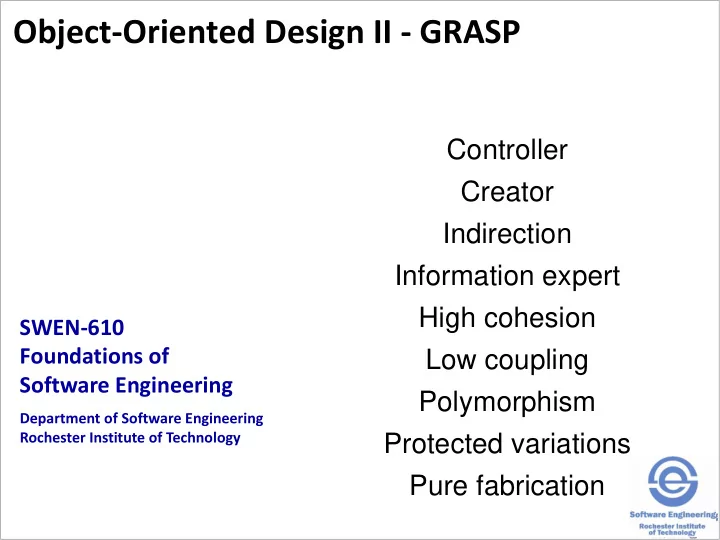

Object-Oriented Design II - GRASP Controller Creator Indirection Information expert High cohesion SWEN-610 Foundations of Low coupling Software Engineering Polymorphism Department of Software Engineering Rochester Institute of Technology Protected variations Pure fabrication
The lesson continues building your object-oriented design skills by looking at GRASP. GRASP – General Responsibility Assignment Software Patterns • Craig Larman, Applying UML and Patterns: An Introduction to Object-Oriented Analysis and Design and Iterative Development You can consider this set of nine design patterns principles when designing your software systems. 2
Some GRASP principles relate to or overlap with SOLID principles. SOLID GRASP S ingle Responsibility Controller O pen/closed Creator L iskov substitution Indirection I nterface segregation Information expert D ependency inversion High cohesion Low coupling Polymorphism Protected variations Pure fabrication 3
This lesson will look at six GRASP principles. GRASP Controller Creator Indirection Information expert High cohesion Low coupling Polymorphism Protected variations Pure fabrication 4
Low Coupling attempts to minimize the impact of changes in the system. Assign responsibility so that (unnecessary) coupling remains low. Note the unnecessary word. Coupling is needed in your system. Resist lowering coupling simply to reduce the number of relationships. • A design with more relationships is often better than the design with fewer relationships. • You need to balance all the design principles. • Beginning designers often place low coupling at the top of their design principles list. It should be lower down! 5
The Law of Demeter addresses unintended coupling within a software system. Limit the range of classes that a class talks to • Each unit only talks to its friends; don't talk to strangers. • Each unit only talks to its immediate friends; don't talk to friends of friends • Chained access exposes each intermediate interface From previous checkers project • board.getPieceAt(i,j).getType() eliminate violation of Law of Demeter and reduce coupling for this class, i.e. may not need to know about Piece • board.getPieceTypeAt(i,j) If you need to talk to something "far away" • Get support from your friend, i.e. new method • Get a new friend, i.e. new direct relationship 6
High Cohesion aims for focused, understandable, and manageable classes. Assign responsibility so the cohesion of classes remains high. High cohesion leads to smaller classes with more narrowly defined responsibilities. This should be high on your list of design goals. High cohesion will require coupling to more classes to get work accomplished. • Do not be afraid of requiring a few more relationships in the pursuit of improved cohesion. 7
Information Expert looks to have behavior follow data. Assign responsibility to the class that has the information needed to fulfill the responsibility. The first place to consider placing behavior that uses/processes attribute data is in the class that holds the attributes. Instead of the client of Flight implementing this: • flt.getDestination().equals("JFK") • flt1.getOrigin().equals("ROC") && flt1.getDestination().equals("JFK") • flt.getArrival() < flt.getDeparture() • flt1.getArrival() + 60 < flt2.getDeparture() Violates encapsulation Consider Flight as the Information expert and Law of Demeter. • boolean Flight.originIs(String airportCode) • boolean Flight.destinationIs(String airportCode) • boolean Flight.itineraryIs(String originCode, String destinationCode) • boolean Flight.arrivesNextDay() • boolean Flight.canConnectWith(Flight flt, unsigned int minConnectTime) 8
Polymorphism creates a hierarchy when related behavior varies by class. Assign responsibility for related behavior that varies by class by using polymorphic behavior. Polymorphism is a primary object-oriented concept and should be used whenever possible Bad code smells that indicate a need for a class hierarchy and polymorphism • Conditional that selects behavior based on a "type" attribute • Use of instanceof or similar language constructs 9
Controller specifies a separation of concerns between the UI tier and other system tiers. Assign responsibility to receive and coordinate a system operation to a class outside of the UI tier. "Controller" is an overused term is software design. • In GRASP, this is not the view "controller" which is firmly in the UI tier. In simple systems, it may be a single object that coordinates all system operations. In more complex systems, it is often multiple objects from different classes each of which handles a single operation. 10
Here is how GRASP controllers fit into the software architecture. Simple System More Complex System UI Tier Appl Tier UI Tier Some Appl Tier class Appl Tier Model through these classes through these classes View controllers work View controllers work Operation Subsystem Tier Operation Model Op1 Op3 Tier Op2 Some Model Tier class 11
Pure Fabrication is sometimes needed to balance other design principles. Assign a cohesive set of responsibilities to a non-domain entity in order to support high cohesion and low coupling. Your design should be primarily driven by the problem domain. Sometimes to maintain a cohesive design you will need to create non-domain classes. Consider the Guessing Game sample webapp • You could maintain the overall number of games played and win ratio as static data in Game • To maintain Game as a cohesive class GameCenter was created. Operation Subsystem is another pure fabrication 12
Recommend
More recommend